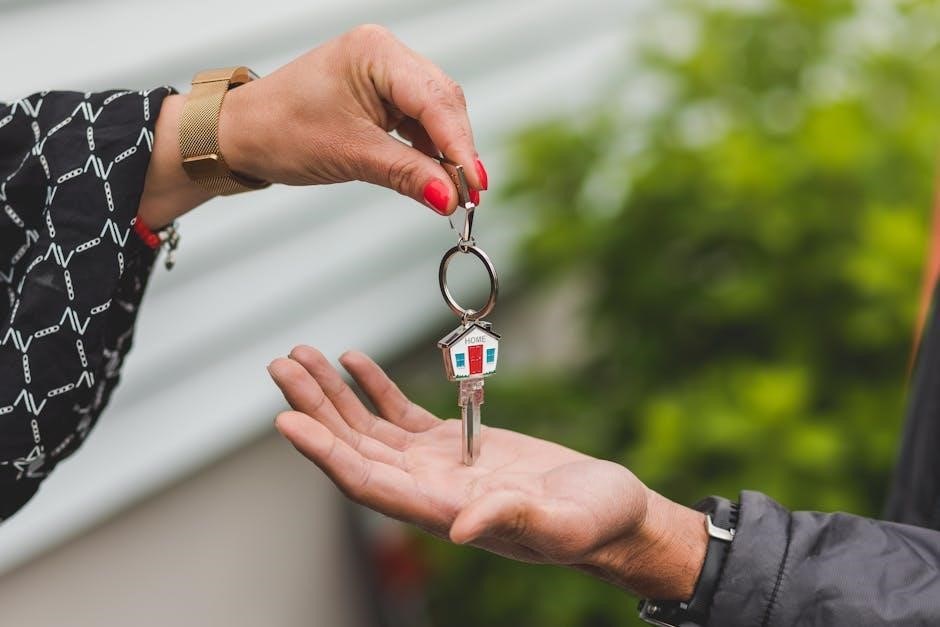A hold harmless agreement is a legal document protecting parties from liability in real estate transactions. It is essential for limiting risks and ensuring legal protection.
1.1 Definition and Purpose
A hold harmless agreement is a legal document that protects one or both parties from liability arising during real estate transactions or activities. Its primary purpose is to limit risks and prevent legal claims by indemnifying the protected party. This agreement is often used in scenarios like property showings, renovations, or short sales, ensuring that individuals or entities are not held responsible for unforeseen damages or injuries. By signing this document, parties agree to release each other from liability, providing mutual protection. It is a crucial tool for safeguarding interests and maintaining smooth operations in real estate dealings.
1.2 Importance in Real Estate Transactions
In real estate, a hold harmless agreement is vital for protecting sellers, buyers, agents, and contractors from potential liabilities. It minimizes risks by clarifying liability allocation, ensuring smoother transactions. This document is especially crucial during property showings, renovations, or short sales, where unforeseen damages or accidents may occur. By signing, parties acknowledge mutual protection, reducing legal disputes. The agreement also provides clarity on responsibilities, fostering trust and confidence among all involved. Its presence ensures compliance with legal standards and safeguards against financial losses, making it an indispensable tool in modern real estate dealings.

Key Components of a Real Estate Hold Harmless Agreement
A real estate hold harmless agreement includes names of parties, property details, indemnification clauses, liability protections, and signatures. It outlines responsibilities and safeguards against legal claims.
2.1 Parties Involved
In a real estate hold harmless agreement, the parties involved typically include the property seller, buyer, real estate agents, brokers, and sometimes contractors or legal entities. The agreement outlines the responsibilities and liabilities of each party, ensuring clarity on who is protected and under what circumstances. For instance, sellers and their agents may be indemnified against claims arising from property showings or inspections. Buyers and their representatives may also be included to protect them from liability during property visits. The agreement ensures all parties understand their roles and legal safeguards, reducing potential disputes. Proper identification of all parties is crucial for the agreement’s enforceability and effectiveness.
2.2 Essential Clauses and Provisions
A real estate hold harmless agreement typically includes several key clauses to ensure comprehensive protection. These provisions often involve indemnification, where one party agrees to compensate another for potential losses or damages. Liability limitations are also standard, outlining the extent of protection for each party. The agreement may specify scenarios, such as property showings or construction work, where the hold harmless clause applies. Additionally, it may address the waiver of claims and damages, ensuring parties cannot pursue legal action for covered incidents. These clauses are designed to provide clarity and legal security, making the agreement enforceable and mutually beneficial for all involved. Properly drafted provisions are essential for avoiding disputes.
2.3 Indemnification and Liability Protection
In a real estate hold harmless agreement, indemnification and liability protection are central to safeguarding parties from legal claims and financial losses. These provisions ensure that one party compensates the other for damages arising from specified events, such as property damage or accidents during showings. Liability protection limits the extent to which a party can be held responsible, offering a shield against unforeseen incidents. The agreement often outlines mutual responsibilities, ensuring that all parties are protected within the scope of the transaction. By including these clauses, the agreement provides clarity and financial security, making it a critical tool in managing risks in real estate dealings. Proper drafting ensures enforceability and fairness for all involved.

How to Obtain a Real Estate Hold Harmless Agreement Template
Download a real estate hold harmless agreement PDF or Word template from legal websites, real estate platforms, or professional services. Ensure it is editable and customizable to suit your needs.
3.1 Sources for Downloading Templates
Real estate hold harmless agreement PDF templates can be downloaded from legal websites, real estate platforms, and professional services. Popular sources include PandaDoc, JotForm, and LawDepot, offering customizable templates. Many real estate associations and title companies also provide free templates. Ensure the template is editable and suitable for your specific needs. Formats like PDF, Word, and Google Docs are commonly available. These templates are designed to protect parties involved in real estate transactions, ensuring legal compliance and clarity. Always verify the template’s compatibility with your local laws and regulations before use.
3.2 Formats Available (PDF, Word, etc.)
Real estate hold harmless agreement templates are available in various formats to suit different needs. The most common formats include PDF, Word, and Google Docs. PDF formats are ideal for easy printing and digital sharing, while Word and Google Docs allow for easy customization. Some platforms also offer Apple Pages formats. These templates are designed to be adaptable, ensuring they can be tailored to specific real estate scenarios. When downloading, choose a format that aligns with your software preferences and editing requirements. Always ensure the template is compatible with your local laws and regulations before finalizing and signing.
Understanding the Legal Implications
A hold harmless agreement legally protects parties from liability, ensuring they are not held responsible for damages or claims arising from real estate transactions or property access.
4.1 Limitations of Liability
In a hold harmless agreement, limitations of liability are clearly defined to protect parties from legal or financial consequences. This provision ensures that neither the seller, agent, nor other involved entities can be held responsible for damages or claims arising from property access or transactions. For instance, during property viewings, the agreement shields real estate agents and sellers from liability for accidents or injuries. Similarly, in construction projects, contractors may be indemnified against claims related to work performed. These limitations are crucial for balancing risk allocation and ensuring fair protection for all parties involved in real estate dealings.
4.2 Waiver of Claims and Damages
A hold harmless agreement often includes a waiver of claims and damages, preventing parties from pursuing legal action for losses or injuries. This provision is mutual, ensuring neither party can claim damages against the other for incidents covered under the agreement. For example, buyers or agents accessing a property may waive claims for injuries sustained during viewings. Similarly, sellers may be protected from claims related to property defects. However, this waiver does not apply to intentional misconduct or gross negligence. Legal counsel should review such clauses to ensure they comply with local laws and are enforceable, balancing protection with fairness for all parties involved in real estate transactions.
4.3 Role of Legal Counsel
Legal counsel plays an indispensable role in drafting, reviewing, and customizing hold harmless agreements for real estate transactions. Attorneys ensure that the agreement complies with local laws and clearly outlines the scope of liability protection. They review clauses to confirm they are enforceable and fair, balancing the interests of all parties involved. Legal experts also provide guidance on how to interpret complex legal terminology and advise on potential risks or loopholes. While templates are available, legal professionals are essential for validating the document’s legality and ensuring it meets specific transaction requirements. Their involvement guarantees that the agreement is tailored to the unique needs of the parties and withstands legal scrutiny.

Scenarios Where a Hold Harmless Agreement is Necessary
A hold harmless agreement is essential in various real estate situations, such as property showings, renovations, or short sales, to protect parties from potential liabilities arising during transactions.
5.1 Property Showings and Viewings
In real estate, a hold harmless agreement is crucial during property showings and viewings. It protects agents, sellers, and buyers from liability for accidents or damages occurring on the premises. Agents often require signed agreements before granting access, ensuring all parties are released from claims arising from injuries or property damage. This legal safeguard is particularly important in cases where visitors may encounter hazards during viewings. By executing the agreement, all parties acknowledge the risks and absolve the property owner and agent of liability. These agreements are readily available in PDF and Word formats, making them easy to customize and implement for real estate professionals. This proactive step ensures smooth and secure property transactions for all involved.
5.2 Renovation or Construction Projects
A hold harmless agreement is essential in real estate renovation or construction projects to protect all parties involved. It ensures that contractors, subcontractors, and property owners are not held liable for unintended damages or injuries. This agreement is particularly important when third-party workers are involved, as it indemnifies the property owner and agents against claims arising from the project. The agreement must be signed before work begins, outlining the scope of protection and liability limitations. Templates for such agreements are widely available in PDF and Word formats, making it easy to customize for specific projects. Legal counsel should review the document to ensure compliance and enforceability.
5.3 Short Sales and Foreclosures
In short sales and foreclosures, a hold harmless agreement is crucial to protect all parties involved, including sellers, buyers, and agents. This agreement ensures that no party is held liable for unforeseen issues arising from the transaction. It is particularly important in cases where multiple stakeholders, such as lenders or third-party vendors, are involved. The agreement must be signed before proceeding with the sale to limit liability and prevent legal disputes. Templates for such agreements are available in PDF and Word formats, allowing for easy customization to fit the specific needs of the transaction. Legal review is recommended to ensure the document is enforceable and comprehensive.

Drafting and Customizing the Agreement
Drafting a hold harmless agreement requires including property details, dates, and specific clauses. Customizing templates ensures the agreement aligns with the transaction’s unique needs and provides legal protection.
6.1 Tailoring the Agreement to Specific Needs
Customizing a hold harmless agreement ensures it addresses the unique aspects of a real estate transaction. Start with a downloadable template, then modify clauses to fit the specific scenario, such as property showings or renovations. Include detailed property information, dates, and the roles of all parties involved. Tailoring the agreement helps protect against potential risks and liabilities associated with the transaction. Clearly define the scope of indemnification and liability protection to avoid ambiguity. Ensure the language is precise and aligns with local laws. Consulting legal counsel during customization is crucial to validate the agreement’s enforceability and completeness.
6.2 Including Property Details and Dates
Including precise property details and dates is crucial for the validity of a hold harmless agreement. Clearly specify the property address, description, and any unique identifiers to avoid ambiguity. Dates are equally important, as they establish the timeline for when the agreement takes effect and when access to the property is granted. For instance, include the date the agreement is signed and the dates during which the property will be accessed. This ensures all parties are aware of their responsibilities within the specified period. Accurate details prevent disputes and ensure the agreement is legally enforceable. Always double-check the information for accuracy before finalizing the document.
6.3 Signatures and Witnesses
Signatures and witnesses are essential to validate a hold harmless agreement. All parties involved, including the property owner, buyer, agent, or contractor, must sign the document to confirm their agreement. Witnesses may also be required to attest to the signing, depending on local laws; Ensure that signatures are accompanied by printed names and dates for clarity. In some cases, notarization is recommended to add an extra layer of authenticity. The agreement becomes legally binding only after all parties have signed and the document has been properly witnessed or notarized. This step ensures that all parties are accountable and acknowledge the terms outlined in the agreement.

Common Mistakes to Avoid
Common mistakes include overlooking key provisions, not seeking legal advice, and incorrect execution of the agreement. Ensure all clauses are clear and legally binding to avoid disputes.
7.1 Overlooking Key Provisions
Overlooking essential clauses in a hold harmless agreement can lead to significant legal and financial consequences. Commonly missed provisions include liability protection, indemnification terms, and property-specific details. Failing to address these can result in unresolved disputes or voided protections. Always ensure the agreement clearly outlines the scope of liability, the parties involved, and the specific property details. Neglecting to include these elements can render the document ineffective, leaving parties vulnerable to claims. Thoroughly review and customize the template to avoid such oversights, and consider legal consultation to ensure all critical provisions are included and enforceable. This step is crucial for maintaining the agreement’s validity and effectiveness in real estate transactions.
7.2 Failing to Consult Legal Advice
Neglecting to seek legal advice when drafting a hold harmless agreement can expose parties to unforeseen risks. Without proper legal review, the agreement may contain ambiguous terms that lead to misunderstandings or legal challenges. Legal experts ensure that the document complies with local regulations and accurately reflects the intended protections. Skipping this step can result in the agreement being deemed unenforceable, leaving all parties vulnerable to litigation. Consulting with a legal professional is crucial to safeguarding interests and ensuring the agreement’s validity, preventing potential disputes and guaranteeing the document meets all necessary legal standards.
7.3 Incorrect Execution or Signing
Incorrect execution or signing of a hold harmless agreement can render it invalid or unenforceable, leading to serious legal consequences. Common mistakes include failing to obtain signatures from all involved parties, neglecting to have the document witnessed, or not notarizing it when required by law. Such oversights can nullify the agreement’s protections, exposing parties to unforeseen liabilities. To prevent this, it’s crucial to ensure all signatures are collected, witnesses are present when necessary, and notarization is completed as required. Proper execution is vital for the agreement to be enforceable and provide the intended legal safeguards effectively.

The Role of Real Estate Professionals
Real estate agents and brokers play a crucial role in facilitating hold harmless agreements, ensuring they are properly drafted, reviewed, and executed to protect all parties involved.
8.1 Real Estate Agents and Brokers
Real estate agents and brokers often facilitate the creation and execution of hold harmless agreements to protect themselves and their clients from potential liabilities. They ensure that the agreements are properly drafted, reviewed, and signed, safeguarding all parties involved in real estate transactions. These professionals provide guidance on the essential clauses and provisions, ensuring compliance with legal standards. By incorporating these agreements, agents and brokers minimize risks associated with property showings, inspections, or other activities. Their expertise helps maintain smooth transactions while protecting their clients’ interests and their own professional reputation. This makes them indispensable in navigating the legal complexities of real estate dealings.
I recall that in the internet information, there were mentions of templates and the importance of legal counsel. So, attorneys likely review these templates to make sure they are enforceable and meet all legal requirements. They might also customize the agreements based on specific needs. Additionally, they could provide advice on how to use these agreements properly and what to avoid.
I should make sure to highlight their expertise in contract law and their role in protecting clients’ interests. Maybe mention how they ensure that the agreements are comprehensive and that all parties understand their rights and obligations. Also, it’s important to note that they help prevent future disputes by making sure everything is clear and legally binding.
Let me start drafting:
Attorneys and legal advisors play a crucial role in the creation and implementation of hold harmless agreements in real estate. Their expertise in contract law ensures that these agreements are legally sound and provide adequate protection for all parties involved. Legal advisors often review and customize templates to fit specific situations, ensuring that the agreements are enforceable and meet all necessary legal standards. They provide valuable insights and advice on how to navigate the complexities of these agreements, helping clients avoid potential pitfalls. By ensuring that all terms are clear and comprehensive, attorneys help prevent future disputes and safeguard their clients’ interests effectively.
Now, I need to check the word count. Let me count the words:
Attorneys
and
legal
advisors
play
a
crucial
role
in
the
creation
and
implementation
of
hold
harmless
agreements
in
real
estate.
Their
expertise
in
contract
law
ensures
that
these
agreements
are
legally
sound
and
provide
adequate
protection
for
all
parties
involved.
Legal
advisors
often
review
and
customize
templates
to
fit
specific
situations,
ensuring
that
the
agreements
are
enforceable
and
meet
all
necessary
legal
standards.
They
provide
valuable
insights
and
advice
on
how
to
navigate
the
complexities
of
these
agreements,
helping
clients
avoid
potential
pitfalls.
By
ensuring
that
all
terms
are
clear
and
comprehensive,
attorneys
help
prevent
future
disputes
and
safeguard
100. their
101. clients’
102. interests
103. effectively.
That’s ; I need to add two more words to reach 105. I can expand on the last sentence.
Maybe change “effectively” to “effectively ensuring peace of mind for all parties involved.”
Now, let me recount:
Attorneys
and
legal
advisors
play
a
crucial
role
in
the
creation
and
implementation
of
hold
harmless
agreements
in
real
estate.
Their
expertise
in
contract
law
ensures
that
these
agreements
are
legally
sound
and
provide
adequate
protection
for
all
parties
involved.
Legal
advisors
often
review
and
customize
templates
to
fit
specific
situations,
ensuring
that
the
agreements
are
enforceable
and
meet
all
necessary
legal
standards.
They
provide
valuable
insights
and
advice
on
how
to
navigate
the
complexities
of
these
agreements,
helping
clients
avoid
potential
pitfalls.
By
ensuring
that
all
terms
are
clear
and
comprehensive,
attorneys
help
prevent
future
disputes
and
safeguard
100. their
101. clients’
102. interests
103. effectively
104. ensuring
105. peace
106. of
107. mind
108. for
109. all
110. parties
111. involved.
Oops, that’s . I went over. I need to trim it down. Maybe remove “for all parties involved” at the end.
Final version:
Attorneys and legal advisors play a crucial role in the creation and implementation of hold harmless agreements in real estate. Their expertise in contract law ensures that these agreements are legally sound and provide adequate protection for all parties involved; Legal advisors often review and customize templates to fit specific situations, ensuring that the agreements are enforceable and meet all necessary legal standards. They provide valuable insights and advice on how to navigate the complexities of these agreements, helping clients avoid potential pitfalls. By ensuring that all terms are clear and comprehensive, attorneys help prevent future disputes and safeguard their clients’ interests effectively ensuring peace of mind.
Now, let me count again:
Attorneys
and
legal
advisors
play
a
crucial
role
in
the
creation
and
implementation
of
hold
harmless
agreements
in
real
estate.
Their
expertise
in
contract
law
ensures
that
these
agreements
are
legally
sound
and
provide
adequate
protection
for
all
parties
involved.
Legal
advisors
often
review
and
customize
templates
to
fit
specific
situations,
ensuring
that
the
agreements
are
enforceable
and
meet
all
necessary
legal
standards.
They
provide
valuable
insights
and
advice
on
how
to
navigate
the
complexities
of
these
agreements,
helping
clients
avoid
potential
pitfalls.
By
ensuring
that
all
terms
are
clear
and
comprehensive,
attorneys
help
prevent
future
disputes
and
safeguard
100. their
101. clients’
102. interests
103. effectively
104. ensuring
105. peace
106. of
107. mind.
Still . I need to cut two words. Maybe change “effectively ensuring peace of mind” to “thus ensuring peace of mind.”
Final version:
Attorneys and legal advisors play a crucial role in the creation and implementation of hold harmless agreements in real
9.1 Final Thoughts on the Importance of Hold Harmless Agreements
A real estate hold harmless agreement is a vital tool for mitigating risks and protecting all parties involved in property transactions. By clearly defining liability limitations, it ensures legal protection and peace of mind. Whether for property showings, renovations, or sales, these agreements safeguard against unforeseen claims and damages. Their availability in customizable templates, such as PDF and Word formats, makes them accessible and easy to adapt to specific needs. However, consulting legal counsel is crucial to ensure compliance and avoid potential pitfalls. Ultimately, a well-drafted hold harmless agreement is indispensable for secure and smooth real estate dealings.
9.2 Encouragement to Use Templates Responsibly
Using real estate hold harmless agreement templates is a practical way to streamline processes, but it’s crucial to do so responsibly. Ensure the template aligns with your specific needs and complies with local laws. Customize the document to include all necessary details, such as property specifics and dates. Always review the agreement with legal counsel to verify its enforceability and completeness. Avoid generic templates that may omit critical clauses, as this could lead to legal vulnerabilities. Remember, a well-executed agreement protects all parties involved. Download templates from reputable sources and use them wisely to maintain professionalism and legal security in your real estate transactions.
